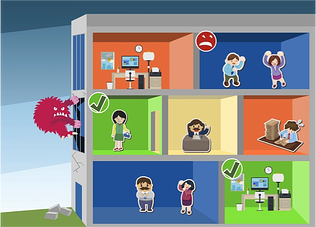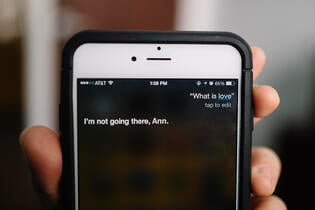Blog
Make 'Em Laugh: 4 Ways to Create e-Learning Courses with Humor
By Ann Iverson, Instructional Designer A recent study from Microsoft Corporation shows that the average attention span for humans has dropped from 12 ...


3 Ways to Design e-Learning for the Modern Learner
By Ann Iverson | August 18, 2015 | Custom Learning | 0 Comments
By Ann Iverson, Instructional Designer
-1.png?width=125&name=Ann(250)-1.png) A recent study from Microsoft Corporation shows that the average attention span for humans has dropped from 12 seconds in the year 2000 to 8 seconds today. Oh look, a squirrel! According to scientists, the age of mobile devices has left humans with a shorter attention span than the common goldfish. Apparently, Goldie beats us out by one second. What’s for dinner? Fish again? Does this mean the end of human civilization as we know it?
A recent study from Microsoft Corporation shows that the average attention span for humans has dropped from 12 seconds in the year 2000 to 8 seconds today. Oh look, a squirrel! According to scientists, the age of mobile devices has left humans with a shorter attention span than the common goldfish. Apparently, Goldie beats us out by one second. What’s for dinner? Fish again? Does this mean the end of human civilization as we know it?
Let’s not panic. The rest of the study shows that, while digital lifestyles decrease our sustained attention overall, it’s only true in the long term. We actually front-load our attention and have more intermittent bursts of high attention. In fact, it seems we humans are actually better at choosing what we want to focus on, and once we engage, we can process the information more quickly. This is good news; who wants a heart surgeon with an attention span of a squirrel? (Actually, squirrels can focus on acorns and nuts for about four minutes, so they beat us out, too.)
What does all of this mean for the e-learning instructional designer? According to many experts in our field, it means that organizations have to rethink their approach to learning so they can cater to the realities that today’s employees face. These recently-named Modern Learners have shorter attention spans, less time to dedicate to training and development, and a preference for personalized learning systems (think just-in-time, just-for-me). Modern Learners want to get the most out of their training in the shortest amount of time—to improve their personal performance, not just check a box that says they’ve completed a course.
Here are 3 ways you can design e-learning courses for the Modern Learner:
1. Engage learners quickly and continuously.
Modern Learners engage when they know the learning event is relevant and intended to improve their individual performance, rather than deliver a lot of content they can access in other ways. If they know they have to repeat the performance on the job, their attention is further heightened. So, rather than start an e-learning course by listing the objectives, try grabbing the learners’ attention by explaining how it will specifically benefit the learners in an authentic way. Want to increase your hourly wage? Turn angry customers into loyal fans? Meet your sales goals this month? Hitting the learners’ “hot buttons” will hook them right away. Then use good design techniques, like immersing the learners in a relatable environment to sustain their engagement. You can read more about learner engagement here and here.
2. Design for performance, not seat time.
Perspectives on course seat times vary. Current trends point to less than 20 minutes. Vine, for instance, tells a story with only six seconds of video, perfect for our shortened attention spans. Seat times have been—and most likely will continue to be—debatable, but the reality is that people can only absorb so much information at one time. After that, content becomes “scrap” learning. By organizing activities into core interactions that achieve performance goals, rather than stretch to a seat time, you can get the most out of your learners’ training time.
3. Let learners build their own scaffolding of learning events that can be searchable.
A single e-learning course doesn’t have to stand alone; it can function as the center of the scaffolding that your learners build, and actually search for, to improve their performance. For example, organizations can create a library of offerings for reusable, searchable content in multiple modalities that learners can access as needed for performance support or to enhance their e-learning activity. Key terms and concepts can be identified, chunked into searchable bites, and tagged so learners can locate modalities easily and quickly―at the very moment that these modalities are most needed. This scaffolding approach could result in toolkits that structure learning into a series of bite-size experiences, creating “just-in-time, just-for-me” learning.
So now you know three ways to design e-learning for the Modern Learner. And really, aren’t we all Modern Learners? Now, congratulate yourself for focusing long enough to make it through this blog!
LIKE WHAT YOU'VE READ? SHARE THE KNOWLEDGE WITH THIS READY-MADE TWEET!
CLICK TO TWEET: 3 Ways to Design e-Learning for the Modern Learner http://hubs.ly/H014ysr0 #aiblog @customelearning
.png?width=135&height=135&name=Ann(250).png)
About the Author: Ann Iverson
Ann is an instructional designer for Allen Interactions who’s consulted for many years with a variety of clients, industries and projects. She learns best by making mistakes!
Comments
Would you like to leave a comment?
Related Blog Posts

By: Ann Iverson | Sep, 2014
Category: Custom Learning, Strategic Consulting

Blog
Make a Learning Love Connection: Five FACTS for Better e-Learning Courses
By Ann Iverson, Instructional Designer A recent study from Microsoft Corporation shows that the average attention span for humans has dropped from 12 ...
By: Ann Iverson | Feb, 2015
Category: Custom Learning

Blog
Stop Scaring Your Learners: 4 Ways to Bring Life to Boring e-Learning ...
By Ann Iverson, Instructional Designer A recent study from Microsoft Corporation shows that the average attention span for humans has dropped from 12 ...
By: Ann Iverson | Oct, 2014
Category: Custom Learning



